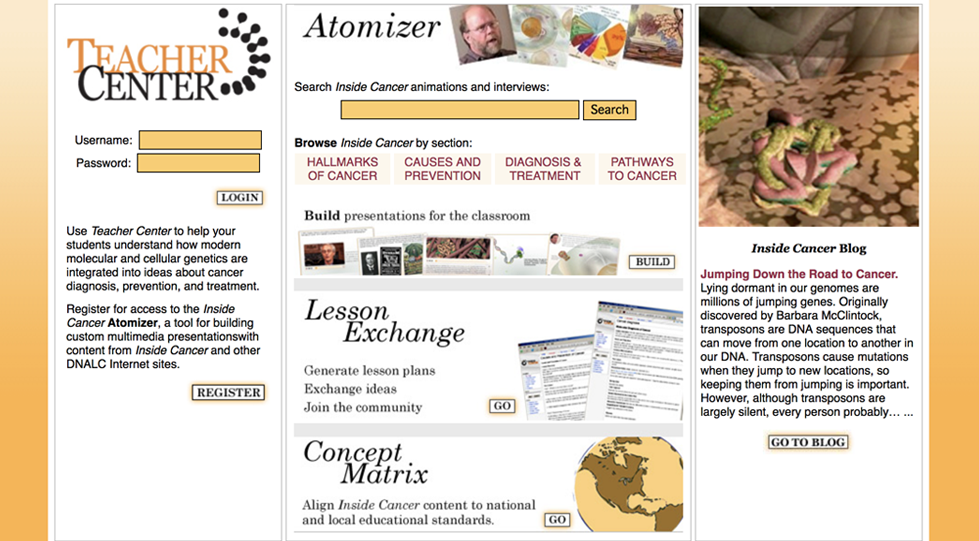Nationwide Dissemination of Inside Cancer: A SEPA-Funded Internet Site for Teachers
 Dolan DNA Learning Center © 2008, Cold Spring Harbor Laboratory. All rights reserved.
Dolan DNA Learning Center © 2008, Cold Spring Harbor Laboratory. All rights reserved.
Project Website(s)
-
Project Description
In January 2006, the Cold Spring Harbor Laboratory’s DNA Learning Center launched its SEPA Phase I project: Inside Cancer, a media-rich internet site that examines the molecular genetic basis of cancer. Phase II of the SEPA project broadly disseminated the site and evaluated its use as a resource in high school biology and health education. It allowed the DNALC to:
- Develop a Teacher Center website with tools to build custom multimedia presentations and collaboratively-generated lesson plans.
- Disseminate the Internet site and teaching tools through first- and second-round workshops to reach faculty nationwide.
- Evaluate general use of the Internet site, effects of workshop participation, and use of the Internet site in science classrooms.
The Teacher Center was launched in October 2008 and has three components: Atomizer, Concept Matrix and Lesson Exchange. The Atomizer allows users to search and organize content within the website. Content was ported to a meta-data system developed for our National Science Digital Library project, the BioSciEdNet (BEN) Collaborative. Each “atom” was annotated with searchable keywords, media type, educational uses, and context. Using a simple editor, a teacher can select content atoms and organize them into custom presentations. The Atomizer can also search content from three other DNALC Internet sites—DNA Interactive, Eugenics Archive, and Genes to Cognition (G2C) Online. This allows teachers to search thousands of multimedia items.
The Concept Matrix cross-references Inside Cancer content atoms with educational standards, enabling teachers to collect items that embody key concepts and standards. Curriculum statements from the American Association for the Advancement of Science Project 2061 Benchmarks and National Academy of Sciences National Science Education Standards have been aligned to the topics and subtopics from the New York State Living Environment Curriculum. Inside Cancer atoms that relate to each statement are listed.
The Lesson Exchange is based on the Wikipedia concept. Lesson plans are submitted by registered teachers, many of whom attended DNALC workshop training, and are available for review and editing by other Lesson Exchange members (http://teachercenter.insidecancer.org/icwiki/index.php/Lessons). Collaborative development of lessons is supported by custom scripts that link the Teacher Center platform to the robust TWiki software package (www.twiki.org/). Three teacher fellows provided initial lesson plans, which were then supplemented and used as models by teacher workshop participants. Each lesson plan includes an overview, goals and objectives, common misconceptions, materials, suggested time required for each lesson, and alignment with curriculum standards.
In 2008–10, DNALC staff conducted 29 first round workshops that were attended by 466 faculty members. These workshops were conducted at national professional meetings and science outreach programs at partner universities and institutions in 20 states and the District of Columbia. The aim of the workshops was to familiarize participants with site content and features, and show them how to build customized lesson plans using Teacher Center.
Qualified first round participants became Regional Fellows who conducted second round training at district in-services or professional conferences from 2009–2011. Regional Fellows reached 378 participants at 33 workshops conducted in 13 states.
-
Abstract
In January 2006 the Dolan DNA Learning Center launched its SEPA Phase I Project: Inside Cancer, a media-rich internet site that examines the molecular genetic basis of cancer. We now propose a Phase II Project which will employ a six-part strategy to broadly disseminate the site and evaluate its use as a resource in high school biology and health education.
a) A partnership will disseminate the site to 800 secondary science teachers at one-day workshop held at 20 sites nationwide. This cost-effective program will focus on key concepts and relevant teaching standards and also provide a dedicated base for conducting second-round training and evaluation activities.
b) An online Teacher Center will allow teachers to develop custom multimedia lessons based on Inside Cancer materials. Key features will be a Concept Matrix Lesson Exchange and Atomizer which will match content with teaching standards facilitate a community approach to lesson plan development and provide a searchable interface of over 3000 multimedia content “atoms.”
c) Fellowships will allow three lead faculty to work directly with DNALC staff to develop the Teacher Center and model lesson plans (DNALC Fellows). Eighty workshop alumni will serve as Regional Fellows and receive stipends to conduct second-round training activities reaching 640 additional teachers.
d) An annual review will assess fidelity to project objectives and analyze site logs to detect patterns of use. An online survey of 1500 Inside Cancer users annually will assess differences in site use among teachers students science and medical professionals and the general public.
e) A longitudinal evaluation of 1,440 participants in workshops and second-round activities will gauge how teachers use Inside Cancer and the Teacher Center and how their teaching behavior changes over time.
f) A controlled study will compare attitudinal and learning effects among 280 high school students—half of whom use Inside Cancer in their classes an half who don’t. Biology and health classes will be selected from a single school district that reflects the ethnic and racial distribution of the U.S. population.
Project Audience
High school teachers and students
Subjects Addressed
Genetics, genomics, cancer
Associated SEPA Project(s)
-
Barcode Long Island: Exploring Biodiversity in a Unique Urban Landscape
R25OD16511-1 : 07/05/2014 - 03/31/2019 -
Inside Cancer Multimedia Education Resources
R25RR015622 : 01/29/2001 - 12/31/2004








